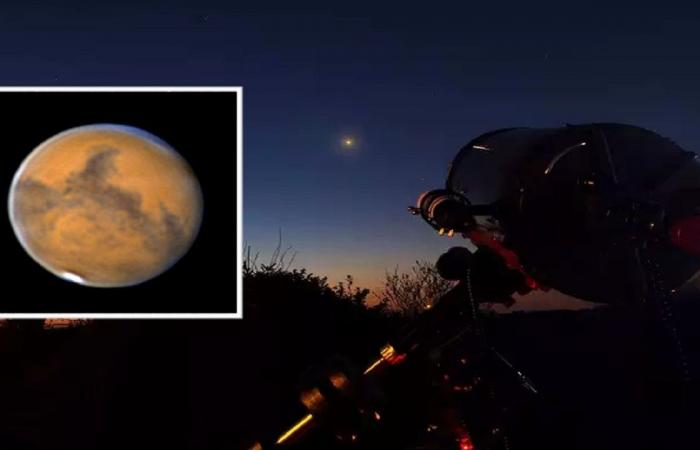The head of the Astronomical Society in Jeddah, Eng. Majed Abu Zahra, stated that Mars will reach the closest distance from our planet on Tuesday, October 6, 2020, and will appear at a width of 22.6 arcseconds (slightly smaller than 2018) at a distance of 62.07 million kilometers, a week before the encounter, and will not come close to such That distance again for the next 15 years or until September 2035.
For comparison, Mars in its historical approach in 2003 was at its closest distance about 60,000 years ago and is now slightly farther from Earth than it was at that time, on August 27, 2003 Mars was at a distance of 55.76 million kilometers, and it will replicate better on August 28, 2287 when The red planet will be at a distance of 55.69 million km.
It can be seen that the arrival of Mars to the closest distance and the encounter do not occur at the same time, and the reason is that the two planets revolve around the sun in elliptical orbits and are not completely rotated and are not in exactly the same plane, where the time interval between the encounter of Mars and the lowest distance with the Earth is 8.5 days (1969), or less than 10 minutes (2208 and 2232).
It takes 687 days for Mars to orbit the Sun, pass its seasonal changes, and go through two equinoxes and two solstices.
The Martian equinox occurs when the sun appears to cross the celestial equator of Mars, while the solstices represent the moment when the sun is at its farthest north or south in the Martian sky.
Mars is the only planet whose surface details can be seen from the Earth, and Mercury is very small, while other planets are covered with clouds, so it is an ideal event for everyone as Mars will be clearly and distinctively visible throughout the night and easy to identify in the dome of the sky.
Mars can be observed on Tuesday evening easily with the naked eye, as it will appear as a point of light burning orange towards the eastern horizon at the beginning of the night, and in the western horizon in the west before dawn and when using the binoculars, it will appear as a point of light without clear features completely as if you are looking at it with the naked eye, so the binoculars are not suitable To monitor Mars.
To see the Martian disk, an observer needs to use an 8-inch and larger telescope, and it is preferable to use color filters to improve the observation, as there is a wide range of appropriate color filters.
The green or blue filter will enhance the polar caps, and the red or orange filter will improve dark details, along with the use of a magnifying glass (Barlow) that connects to the eyepiece of the telescope to improve vision.
The southern half of Mars can be seen tilting toward the Earth, and dark and lighter regions are seen on the planet’s disk due to differences in light reflectance, with lighter areas representing deserts while darker areas are rocks.
In addition, the planet’s Antarctic dome shines brightly, but since it is in the southern summer, this dome will shrink to a fraction of its full size.
As for the Arctic Dome, it is currently behind the northern end of the planet, but there are blue clouds spread over it that can be observed, and the reason for its blue color is that it consists of ice crystals of water and carbon dioxide that scatter the short blue wavelengths of sunlight, knowing that rain does not fall on Mars Because the atmosphere is thin, and the low temperatures and pressure mean that water can only exist there in the form of steam or ice.
Since the Earth rotates on its axis about 40 minutes faster compared to Mars, it is possible for the next few weeks to see many surface features, and when observing Mars from a dark location and a clear sky devoid of the presence of the moon, there is an opportunity to see the moons of Mars Phobos and Deimos through the telescope except It is not visible to the naked eye.
In general, the period from October 6 to October 28 will provide the opportunity to see different features of the surface of Mars as the planet rotates on its axis, and unlike most astronomical events that last for a short period or one night, the period of this event of several weeks will provide many opportunities for frequent observation and improvement of observation skills.
These were the details of the news Astronomical Jeddah: The closest distance between Mars and Earth next Tuesday for this day. We hope that we have succeeded by giving you the full details and information. To follow all our news, you can subscribe to the alerts system or to one of our different systems to provide you with all that is new.
It is also worth noting that the original news has been published and is available at saudi24news and the editorial team at AlKhaleej Today has confirmed it and it has been modified, and it may have been completely transferred or quoted from it and you can read and follow this news from its main source.

